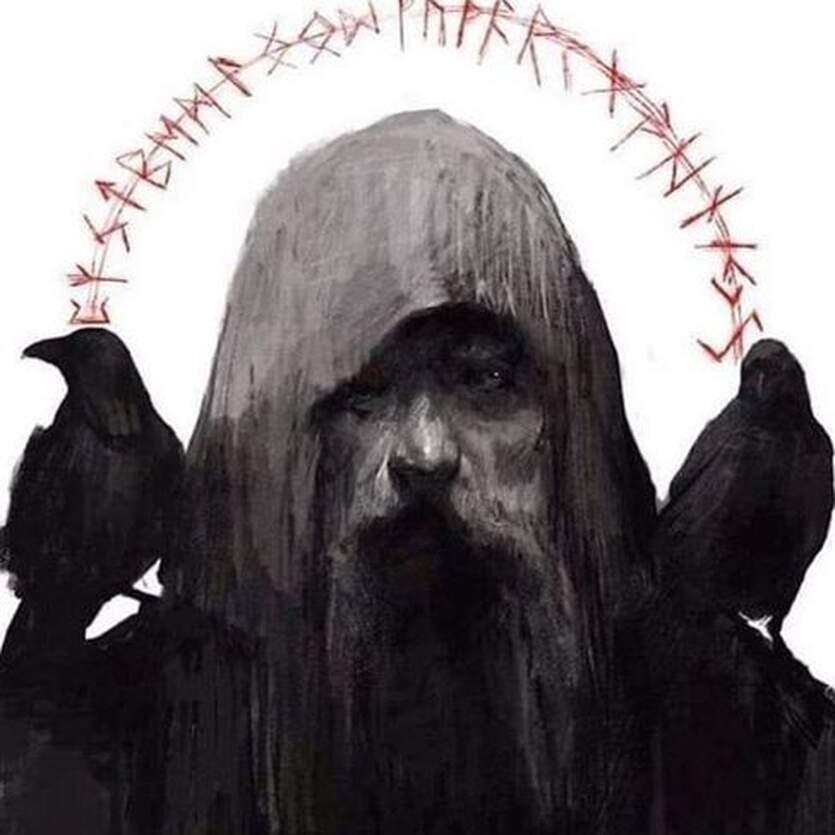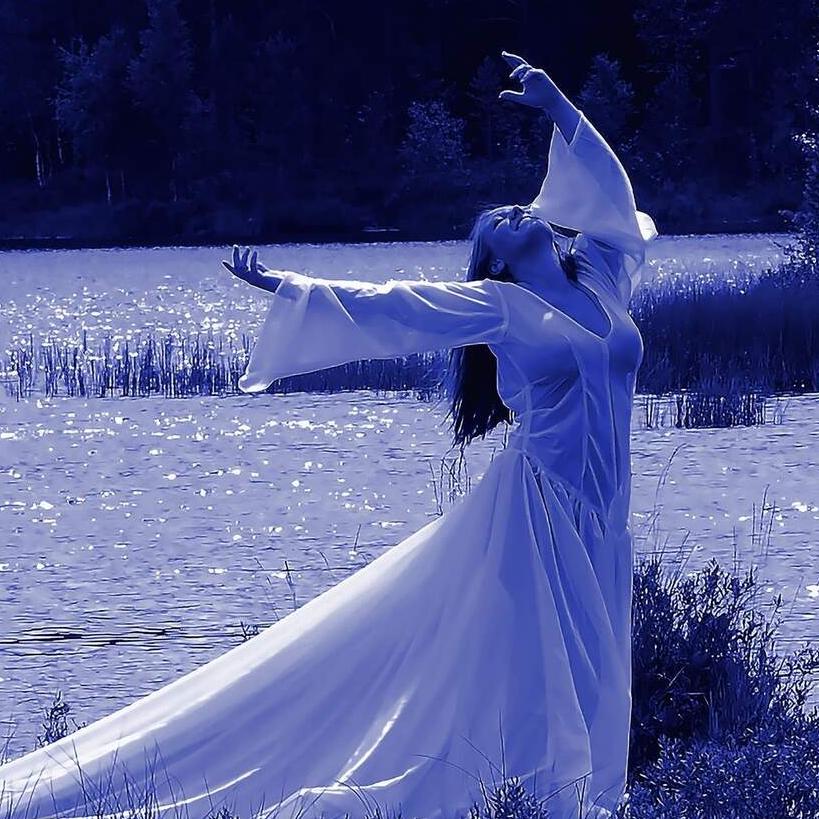Loki, the Changer of Ways, and the Heralds of Ragnarök
Part 2
Hel was born half-dead into the world, her deeply fateful blood turning her into a symbol of the anguish of death, the fleeting perfection of a young woman in her prime of beauty, and the mouldering corpse that lies beneath every tragic fate. Both came together in Hel, and with it came the cold and certain tones of a being who knew exactly what her purpose would be, and embraced it with grim determination. In her realm of Helheim, the dead who perish of disease and old age come to her in her dwelling of Eljuthnir, a large hall with many walls and gates where the dead rest or serve Hel in whatever form she wishes. It is a place where no fires burn, a cheerless place in the region of Niflheim where the darkness of that realm is felt in every moment. Those who make offerings to Hel to understand the wisdom of death must be very intuitive of her wishes, for although the surrendering of personal objects for the dead in Helheim is a common practice, the more dear the possession the more likely it is to sway her to impart something to those who offer it to her.
Her brother Jormungandr, also called the Midgard serpent, started out small just like his brother Fenrir, but grew to enormous size once in the waters of Midgard, growing so large that he encircles the world. He was once caught by Thor on a fishing expedition that almost had very deadly results for both Thor and his unwitting fellow fisherman Hymir, who outdid him at the feast put on by Aegir and Rhan. Thor did not take that very well,for he is always a rival of Jotnar. That day, Thor almost ended Jormundgandr’s life with a blow of his hammer, and would have done so if Hymir had not cut Thor’s line! But this was not the only time that Thor tangled with Jormungandr, for in the house of Utgartha-Loki when he was being tested by the Jotnar, he was asked to lift the household cat, which he did by one paw with extreme effort! What Thor did not know was that the cat was an illusion, just as the other challenges were, and he was actually lifting up Jormungandr himself! The rivalry between these two will end during Ragnarök, when Thor will kill the serpent, but be poisoned by his fangs and die in nine steps. I do not know of many Heathens making offerings to Jormungandr, but I suppose it is possible.
* Of the last of the Heralds of Ragnarök, we have learned much already. We have learned of his binding by Tyr and the sacrifice that was made, we have learned that he will devour the Allfather on the shattered span of Bifrost during Ragnarök, and we know that he will be destroyed in turn by Vithar. We know he is the father of the wolves that will chase the sun and the moon. What we might wonder is what might have been if the gods had not chained him, and persuaded him that indeed he had potent enemies. It was in his blood to be their enemy, or so it seemed from the perspective of the gods who for the most part had the same blood. Jotnar spirits have a strong connection with the same sense of wyrd that is possessed by the Nornir, and it is interesting to think that perhaps many of those we deem villains or ravagers in our stories might simply be playing their part. For a certainty, Fenrir has played his up to this point, and we fear the final days when he plays out the rest.
Loki, Angrboda, and their children are a riddle of the wyrd that we are yet to unravel, for we Heathens are merely mortals grasping at difficult concepts of time that stand outside the bounds of our own…this concept asks us to see it as if flipping the pages back and forth through a book until even the book disappears, and the sound of flipping pages remain. Only in the Well of Urth are these things possible to imagine. For us, understanding the actions of Loki as a slow accumulation of movements towards the future is all we can grasp. In this way, we might see the passage of time as the Allfather, with one thing being responsible for the next, one deed following another because it must. Therefore I ask you to look at Loki in such a way, for although his actions may indicate mischief and malice, it may be that is the only way he may act in the dictate of his wyrd.
After his transgressions against the gods, Loki is bound to a stone in a cave with the intestines of his son Narfi by his other son Vali while a serpent is placed above his face. Sigyn is placed in the cave with Loki to bear away the venom that drops and burns his face in a bowl, the in between moments when she empties it being agony for Loki as the burning drops torment him. But eventually, Loki will free himself when the forests and mountains shake, and Ragnarök comes. He will then be at the forefront of a force of Jotnar, leading a ship made of men’s bones and fingernails towards the burning city of Asgard. There he will fight Father Heimdall, and they will die together. This is a glimpse of the end that the prophecy of the Voluspa foretells…
Loki, the Changer of Ways, and the Heralds of Ragnarök
Part 2
Hel was born half-dead into the world, her deeply fateful blood turning her into a symbol of the anguish of death, the fleeting perfection of a young woman in her prime of beauty, and the mouldering corpse that lies beneath every tragic fate. Both came together in Hel, and with it came the cold and certain tones of a being who knew exactly what her purpose would be, and embraced it with grim determination. In her realm of Helheim, the dead who perish of disease and old age come to her in her dwelling of Eljuthnir, a large hall with many walls and gates where the dead rest or serve Hel in whatever form she wishes. It is a place where no fires burn, a cheerless place in the region of Niflheim where the darkness of that realm is felt in every moment. Those who make offerings to Hel to understand the wisdom of death must be very intuitive of her wishes, for although the surrendering of personal objects for the dead in Helheim is a common practice, the more dear the possession the more likely it is to sway her to impart something to those who offer it to her.
Her brother Jormungandr, also called the Midgard serpent, started out small just like his brother Fenrir, but grew to enormous size once in the waters of Midgard, growing so large that he encircles the world. He was once caught by Thor on a fishing expedition that almost had very deadly results for both Thor and his unwitting fellow fisherman Hymir, who outdid him at the feast put on by Aegir and Rhan. Thor did not take that very well,for he is always a rival of Jotnar. That day, Thor almost ended Jormundgandr’s life with a blow of his hammer, and would have done so if Hymir had not cut Thor’s line! But this was not the only time that Thor tangled with Jormungandr, for in the house of Utgartha-Loki when he was being tested by the Jotnar, he was asked to lift the household cat, which he did by one paw with extreme effort! What Thor did not know was that the cat was an illusion, just as the other challenges were, and he was actually lifting up Jormungandr himself! The rivalry between these two will end during Ragnarök, when Thor will kill the serpent, but be poisoned by his fangs and die in nine steps. I do not know of many Heathens making offerings to Jormungandr, but I suppose it is possible.
* Of the last of the Heralds of Ragnarök, we have learned much already. We have learned of his binding by Tyr and the sacrifice that was made, we have learned that he will devour the Allfather on the shattered span of Bifrost during Ragnarök, and we know that he will be destroyed in turn by Vithar. We know he is the father of the wolves that will chase the sun and the moon. What we might wonder is what might have been if the gods had not chained him, and persuaded him that indeed he had potent enemies. It was in his blood to be their enemy, or so it seemed from the perspective of the gods who for the most part had the same blood. Jotnar spirits have a strong connection with the same sense of wyrd that is possessed by the Nornir, and it is interesting to think that perhaps many of those we deem villains or ravagers in our stories might simply be playing their part. For a certainty, Fenrir has played his up to this point, and we fear the final days when he plays out the rest.
Loki, Angrboda, and their children are a riddle of the wyrd that we are yet to unravel, for we Heathens are merely mortals grasping at difficult concepts of time that stand outside the bounds of our own…this concept asks us to see it as if flipping the pages back and forth through a book until even the book disappears, and the sound of flipping pages remain. Only in the Well of Urth are these things possible to imagine. For us, understanding the actions of Loki as a slow accumulation of movements towards the future is all we can grasp. In this way, we might see the passage of time as the Allfather, with one thing being responsible for the next, one deed following another because it must. Therefore I ask you to look at Loki in such a way, for although his actions may indicate mischief and malice, it may be that is the only way he may act in the dictate of his wyrd.
After his transgressions against the gods, Loki is bound to a stone in a cave with the intestines of his son Narfi by his other son Vali while a serpent is placed above his face. Sigyn is placed in the cave with Loki to bear away the venom that drops and burns his face in a bowl, the in between moments when she empties it being agony for Loki as the burning drops torment him. But eventually, Loki will free himself when the forests and mountains shake, and Ragnarök comes. He will then be at the forefront of a force of Jotnar, leading a ship made of men’s bones and fingernails towards the burning city of Asgard. There he will fight Father Heimdall, and they will die together. This is a glimpse of the end that the prophecy of the Voluspa foretells…






















